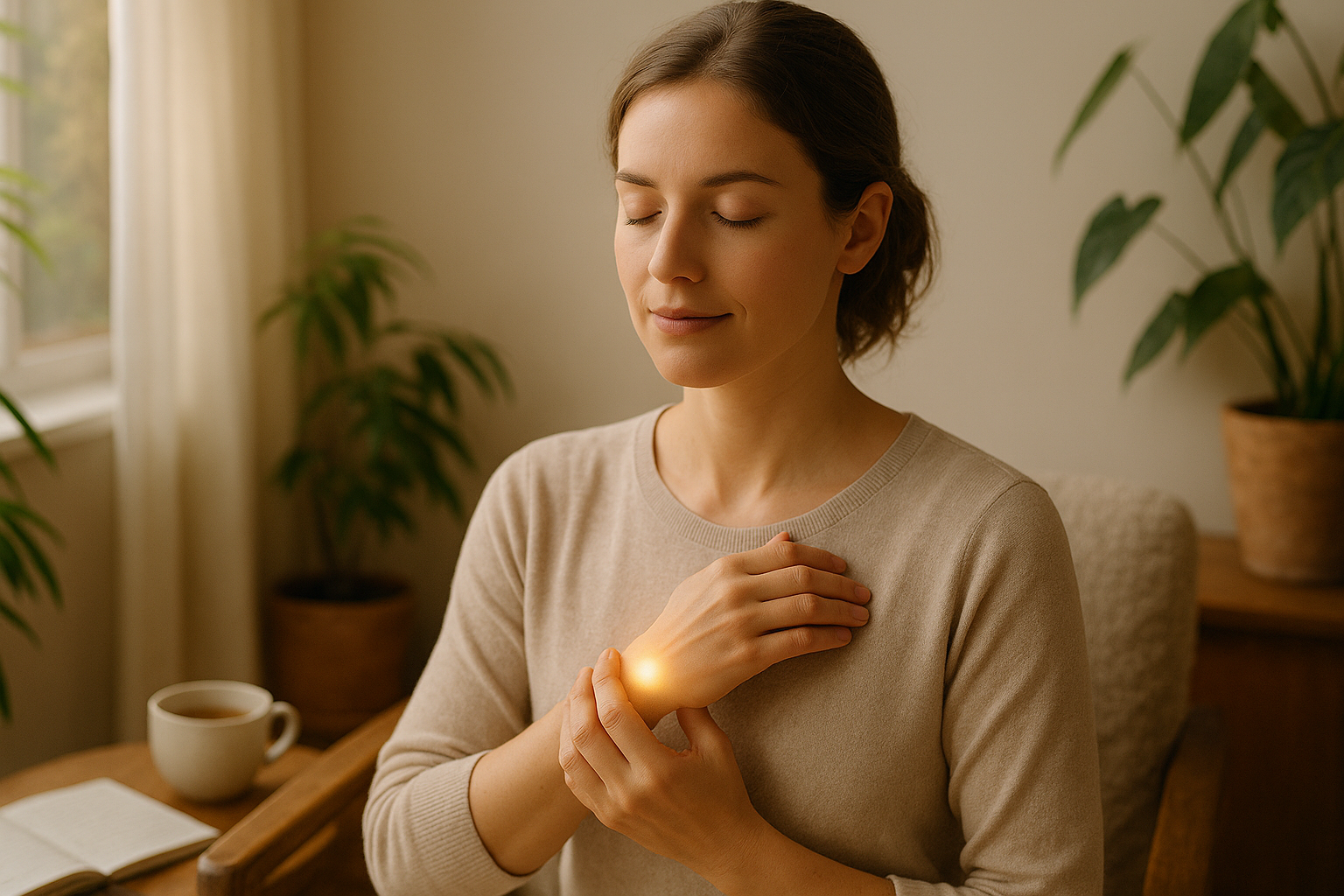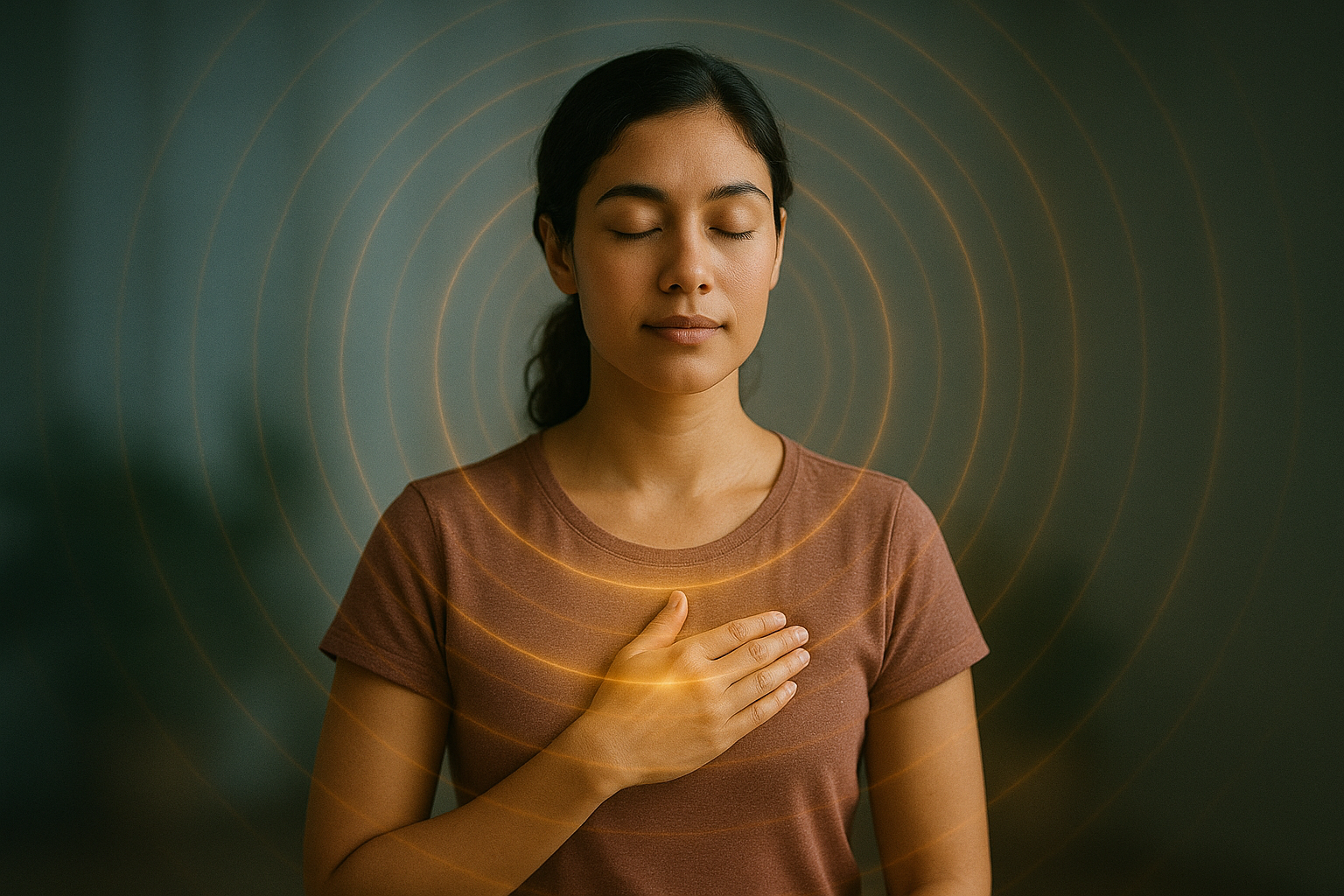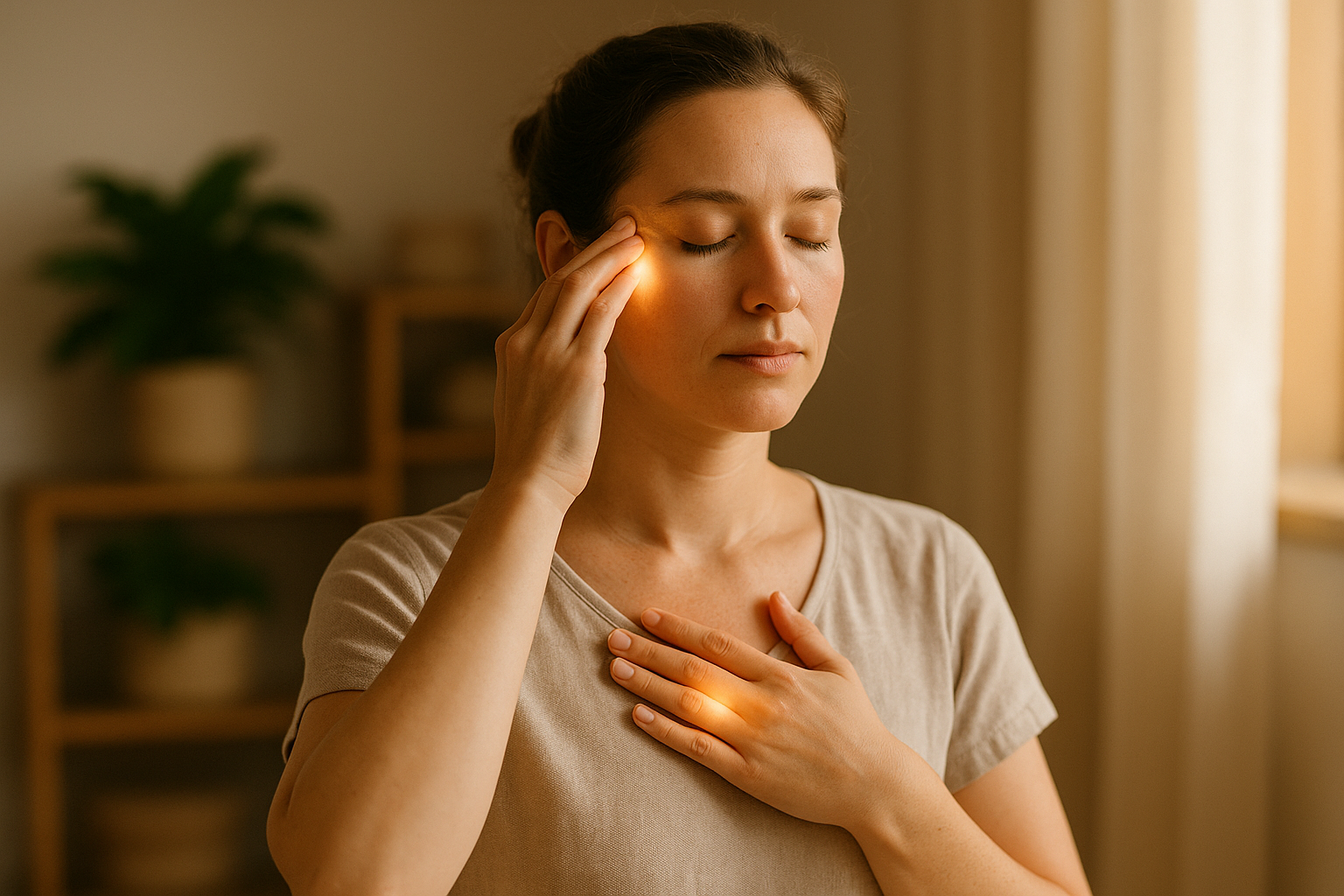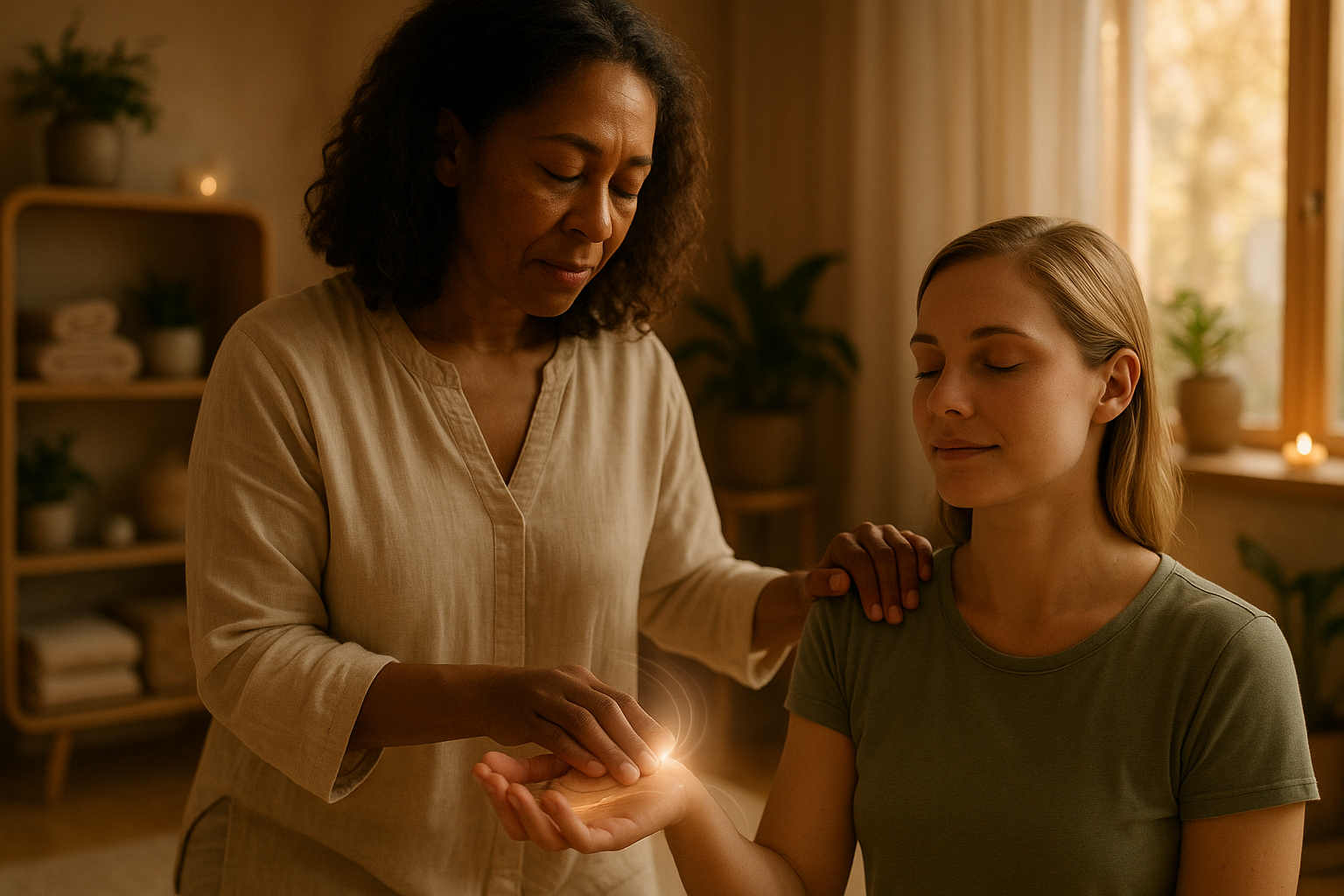Estimated Reading Time: 12 minutes
Introduction: Calm Is a Skill, Not a Circumstance
 In a world that moves faster than our nervous systems can process, calm often feels like a luxury — something reserved for quiet retreats or moments of rare stillness. Yet ancient traditions remind us that calm is not about changing our environment but about changing how we inhabit it.
In a world that moves faster than our nervous systems can process, calm often feels like a luxury — something reserved for quiet retreats or moments of rare stillness. Yet ancient traditions remind us that calm is not about changing our environment but about changing how we inhabit it.
Acupressure, a cornerstone of Traditional Chinese Medicine (TCM), offers a gentle, body-based pathway to emotional balance. Through mindful touch and subtle awareness of energy flow, we can engage the body’s own wisdom to soothe anxiety, release tension, and cultivate steadiness in everyday life.
Modern research is beginning to affirm what healers have known for centuries: pressing specific points on the body can influence the nervous system, balance hormones, and ease emotional distress. When combined with mindfulness and self-compassion, acupressure becomes more than a relaxation technique — it becomes a daily practice of emotional regulation.
What You Will Learn
By the end of this article, you will understand:
-
The science and philosophy behind acupressure and how it supports emotional wellness
-
The body–mind connection through meridians and energy flow
-
Five key acupressure points to relieve common emotional imbalances such as anxiety, sadness, and overwhelm
-
How to integrate acupressure into your daily routine with mindful breathing and self-compassion
-
Safety guidelines and tips for practicing acupressure at home
1. The Body as a Gateway to Emotional Balance
Our emotions don’t just live in the mind — they live in the body. When you’re anxious, your chest tightens; when you’re sad, your shoulders slump; when you’re angry, your jaw clenches. Acupressure acknowledges this inseparability of body and emotion, using gentle touch to restore harmony in the energy network that links them.
The Philosophy Behind Acupressure
In TCM, energy or qi flows through pathways known as meridians. Each meridian corresponds to specific organs and emotional states. For example, the liver meridian relates to anger and frustration, while the lung meridian is associated with grief and letting go.
When qi becomes stagnant or blocked — often due to stress, trauma, or overthinking — physical symptoms and emotional imbalances appear. Acupressure works by stimulating specific points along these meridians to release tension, enhance circulation, and reestablish equilibrium.
Modern Science Meets Ancient Wisdom
Contemporary studies have shown that acupressure can activate the parasympathetic nervous system — the body’s natural “rest and digest” response. Research published in the Journal of Alternative and Complementary Medicine found that stimulating acupoints reduced cortisol levels and improved heart-rate variability, key markers of stress recovery (Lee et al., 2012).
In other words, pressing a point on your wrist or forehead isn’t just symbolic — it has measurable effects on how your brain and body handle stress.
2. Emotional Wellness Through the Lens of Energy Flow
To understand how acupressure nurtures emotional calm, it helps to visualize your body as a dynamic landscape of rivers and currents. When energy flows smoothly, emotions move freely — we feel resilient, grounded, and alive. When energy stagnates, we feel stuck, reactive, or depleted.
Meridians and Emotions
-
Lung Meridian: Linked to sadness and letting go.
-
Heart Meridian: Governs joy, love, and emotional expression.
-
Liver Meridian: Connected to anger, frustration, and decision-making.
-
Spleen Meridian: Tied to overthinking, worry, and self-nurturing.
-
Kidney Meridian: Associated with fear, courage, and willpower.
By pressing certain points, we can help each of these emotional energies regain movement — much like releasing a kink in a hose allows water to flow again.
The Power of Touch and Attention
Touch itself is therapeutic. Research on affective touch shows that slow, gentle pressure activates C-tactile fibers — nerve endings that send signals of safety and connection to the brain (McGlone et al., 2014). This means that mindful acupressure is not only about mechanical stimulation but also about sending the message: You are safe. You can relax.
3. Five Key Acupressure Points for Everyday Emotional Wellness
The following points are safe, accessible, and effective for self-care. You can use them at home, at work, or anytime you need to center yourself.
Before you begin, take a few slow breaths. Let your touch be gentle, not forceful — imagine you are listening to your body through your fingertips.
1. Heart 7 (Shen Men) — “Spirit Gate”
Location: On the wrist crease, on the pinky-side near the base of the palm.
Use For: Anxiety, restlessness, insomnia, emotional agitation.
How to Apply: Press gently with your thumb in circular motions for 1–2 minutes while breathing slowly.
Mindful Affirmation: “I open the gate to peace and let my heart rest.”
Why It Works: Shen Men calms the heart and stabilizes the spirit. Studies show that stimulating this point can reduce physiological symptoms of anxiety and promote relaxation (Yeh et al., 2009).
2. Pericardium 6 (Nei Guan) — “Inner Gate”
Location: Three finger widths below the wrist crease, between the two tendons in the center of the inner forearm.
Use For: Anxiety, nausea, emotional overwhelm, panic attacks.
How to Apply: Press both sides simultaneously or use your thumb to massage in a gentle circular motion for 2–3 minutes.
Mindful Affirmation: “I am safe. I am steady.”
Why It Works: PC6 helps regulate heart rhythm and calm the mind. It is frequently used to ease nausea and anxiety by balancing the heart and stomach meridians.
3. Lung 1 (Zhong Fu) — “Central Treasury”
Location: Slightly below the outer collarbone, near the shoulder.
Use For: Sadness, grief, difficulty letting go, shallow breathing.
How to Apply: Use your fingertips to press gently on both sides while taking deep, slow breaths, expanding the chest.
Mindful Affirmation: “I release what no longer serves me.”
Why It Works: LU1 opens the chest, deepens breathing, and helps process grief. In TCM, the lungs govern both breath and the emotion of sadness, so this point is often used for emotional release.
4. Liver 3 (Tai Chong) — “Great Rushing”
Location: On the top of the foot, between the first and second toes, about two finger widths above the webbing.
Use For: Anger, irritability, frustration, mood swings.
How to Apply: Apply firm but comfortable pressure with your thumb for 1–2 minutes on each foot.
Mindful Affirmation: “I let energy flow freely through me.”
Why It Works: LV3 is one of the most powerful points for moving stagnant energy. It harmonizes the liver, improves emotional flexibility, and can relieve headaches or tension caused by suppressed anger.
5. Governing Vessel 20 (Bai Hui) — “Hundred Meetings”
Location: At the crown of the head, on the midline between the tops of the ears.
Use For: Overthinking, fatigue, low mood, mental fog.
How to Apply: Place your palms gently on the top of your head, let your fingers meet at the midline, and apply light circular pressure.
Mindful Affirmation: “I lift my mind to clarity and calm.”
Why It Works: GV20 connects all major meridians, uplifting the spirit and balancing yin and yang energies. It is often used to relieve depression and mental exhaustion.
4. Integrating Acupressure Into Daily Life
Acupressure doesn’t require a special setting or long sessions. With a little intention, you can weave it into the rhythm of your day.
 Morning Grounding Ritual
Morning Grounding Ritual
Begin your day by pressing LV3 (between your toes) and GV20 (crown of head) to awaken energy and focus. Pair this with three slow breaths to anchor your mind before the rush of the day.
Midday Reset
When tension builds, use PC6 or HT7 at your desk or during a break. A minute or two of pressure while consciously relaxing your shoulders can recalibrate your nervous system.
Evening Unwind
Before bed, try LU1 to release emotional residue from the day. Combine it with gratitude journaling or a few moments of self-massage on your neck and shoulders.
Pairing With Mindfulness and Self-Compassion
Acupressure becomes even more powerful when paired with mindful breathing and gentle self-talk. Instead of “fixing” yourself, approach each session as an act of kindness.
You might say to yourself:
-
“I am listening to what my body needs.”
-
“This moment of care is enough.”
-
“Calm is something I create, not something I wait for.”
5. The Science of Touch and Self-Regulation
While acupressure’s traditional framework revolves around meridians and qi, modern research offers physiological explanations that align beautifully with its effects.
Activation of the Parasympathetic Nervous System
Touching acupoints gently can stimulate the vagus nerve, a key player in emotional regulation. Studies have shown that vagal activation promotes relaxation, reduces inflammation, and enhances emotional resilience (Porges, 2011).
Reduction of Stress Hormones
Repeated acupressure practice has been associated with decreased cortisol levels and improved sleep quality (Chen et al., 2013). This means your body learns to return to balance more easily after stress.
Mind-Body Synchrony
The practice of mindful acupressure fosters interoceptive awareness — the ability to sense internal states. Greater interoceptive awareness is linked to emotional intelligence and reduced anxiety (Farb et al., 2015).
In essence, each time you touch a pressure point, you are strengthening the neural pathways of calm.
6. When Emotions Speak Through the Body
Acupressure can be a bridge between physical sensations and emotional insight. For example:
-
Tightness in the chest might reveal unexpressed grief.
-
Jaw tension might hide suppressed anger.
-
A heavy stomach might reflect worry or guilt.
Rather than resisting these sensations, acupressure invites gentle curiosity. As you hold a point, ask:
“What is this tension trying to tell me?”
Often, awareness itself begins to dissolve the discomfort.
7. Safety and Best Practices
While acupressure is generally safe, a few guidelines ensure it remains supportive rather than stressful:
-
Avoid pressing directly on open wounds, bruises, or inflamed skin.
-
Use gentle pressure — discomfort is a signal to ease off, not to push harder.
-
Consult a professional if you are pregnant, have heart conditions, or serious medical concerns.
-
Consistency matters: a few minutes daily is more effective than a long session once a week.
Remember, the goal isn’t perfection. It’s cultivating a relationship with your body rooted in respect and compassion.
8. Acupressure as a Daily Practice of Presence
At its heart, acupressure is mindfulness embodied. Each point you touch is an invitation to return — to your breath, your sensations, and your inner steadiness.
When you hold a point with awareness, you are saying to your nervous system: You are safe here. You belong here. Over time, this simple ritual can rewire how you respond to life’s challenges — shifting from reactivity to resilience.
Calm, then, is not something we achieve. It’s something we remember — through the body, through the breath, through the quiet power of our own hands.
9. Building Your Own “Calm Routine”
You can design a short sequence of acupressure points to fit your personal needs:
| Emotion / Need | Recommended Points | Affirmation |
|---|---|---|
| Anxiety / Panic | HT7, PC6 | “I am grounded and safe.” |
| Sadness / Grief | LU1, HT7 | “I breathe in healing; I release with ease.” |
| Anger / Frustration | LV3, GV20 | “I allow energy to move freely.” |
| Overthinking / Worry | GV20, SP6 | “My mind rests in clarity.” |
| Fatigue / Burnout | ST36, GV20 | “I renew my energy with each breath.” |
You might also pair acupressure with aromatherapy, gentle stretching, or a few mindful sips of tea to create a soothing ritual.
10. From Stress Relief to Self-Leadership 
When practiced regularly, acupressure becomes more than symptom management — it becomes self-leadership.
By consciously calming your body, you train your nervous system to stay composed under pressure. This, in turn, enhances emotional intelligence, decision-making, and relationships.
As psychologist Daniel Goleman reminds us, emotional regulation is foundational to resilience and well-being. Acupressure offers a direct, tactile way to practice that regulation daily — not just in meditation halls, but in the middle of ordinary life.
Conclusion: Calm at Your Fingertips
Every fingertip has the potential to be a messenger of calm. Each point you press is a conversation between body and mind — a reminder that you hold the power to soothe, balance, and restore yourself.
In times of emotional turbulence, touch is a bridge — from thought to sensation, from chaos to clarity. Acupressure invites us to embody calm, not as an idea but as a lived experience available in every breath, every heartbeat, every moment we choose to listen within.
So the next time stress rises, pause. Place a hand over your heart or wrist, breathe slowly, and remember: calm is not out there. It’s right here, under your fingertips.
References
-
Chen, H., et al. (2013). “The effects of self-administered acupressure on stress and sleep quality.” Complementary Therapies in Medicine, 21(4), 282–290.
-
Farb, N. A. S., et al. (2015). “Interoception, contemplative practice, and health.” Frontiers in Psychology, 6(763).
-
Lee, M. S., et al. (2012). “Effects of self-acupressure on stress and immune function: A randomized controlled trial.” Journal of Alternative and Complementary Medicine, 18(1), 19–24.
-
McGlone, F., et al. (2014). “The role of gentle touch in regulating affective and social behavior.” Neuroscience & Biobehavioral Reviews, 34(2), 155–163.
-
Porges, S. W. (2011). The Polyvagal Theory: Neurophysiological Foundations of Emotions, Attachment, Communication, and Self-Regulation. W. W. Norton.
-
Yeh, C. H., et al. (2009). “A randomized clinical trial of acupressure and its effect on anxiety and sleep quality.” American Journal of Chinese Medicine, 37(3), 451–460.





